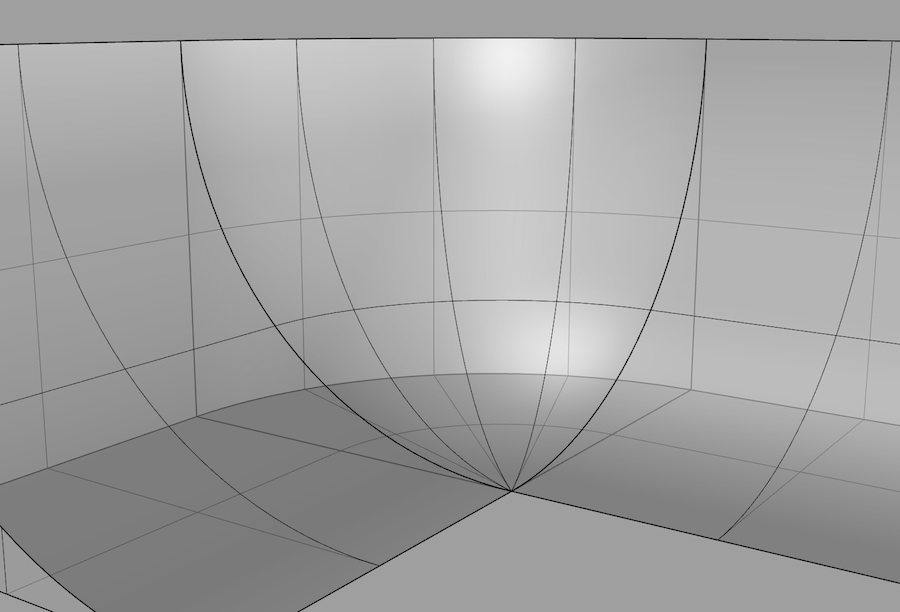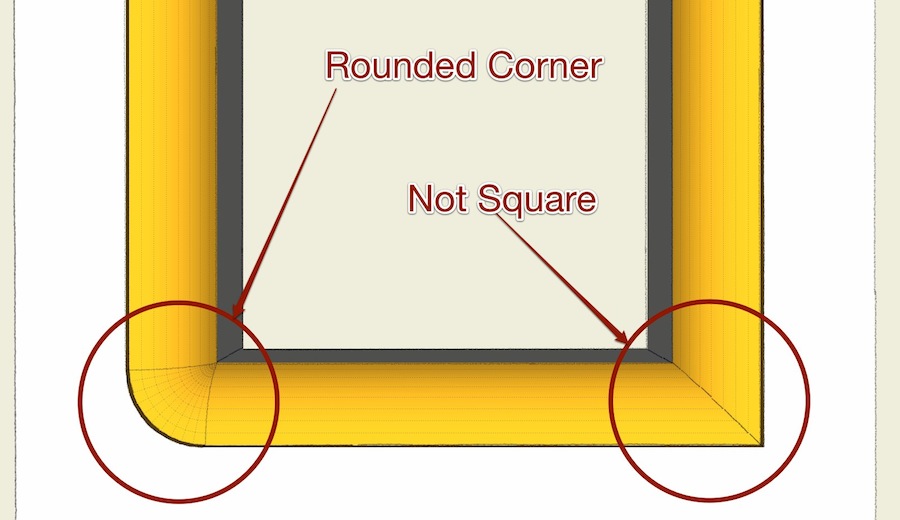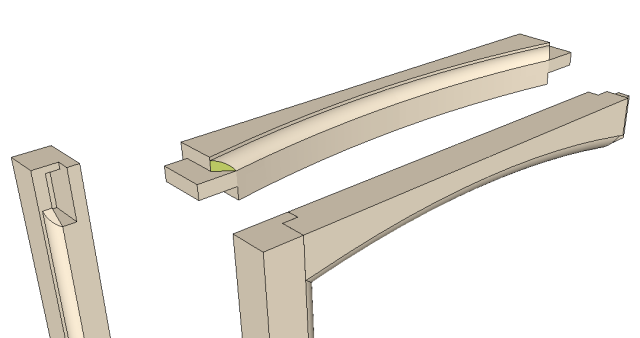Strange behaviour of SU when molding a door
-
Hi Jeff, hi folks.
I agree with you about the use of SU for real world construction. After all, SU is a sketching program.
However, with carefull use, as is the case with all tools, it can be used to some extent.
See attached SU file for ideas.
-
@jean lemire said:
Hi Jeff, hi folks.
I agree with you about the use of SU for real world construction. After all, SU is a sketching program.
i dunno, sketchup is super accurate in most cases (especially when dealing with mid to large size construction drawings)..
i use the app with full confidence in my work.. it's just that over the years, i've learned (often the hard way ) where it breaks down and how to avoid the problems..
) where it breaks down and how to avoid the problems..over the past couple of years, i've learned another app (nurbs based) which picks up the slack when sketchup fails.. using the two apps together instead of one OR the other is seemingly one of the smarter work related decisions i've made lately
but when it comes to situations like these, Rhino doesn't even bat an eye


-
@brandy20 said:
Molded door, using Extrude Edges by Lathe. Works very well and the workflow is pretty fast.
there are a couple of improvements/changes in the way EEbL works that would make my life a teenytiny bit easier but..
i feel like i've bugged TIG enough on the lathe tool already.. i'll give it another couple of months before i start with another round of suggestions
-
Per request http://sketchup.google.com/3dwarehouse/details?mid=97f6c7269341fe93483a6eca16661274 below the OP scale the model starts to have SU size issues.
Barndy20 please reconsider trying to mould the component approach it is dangerous -
@mac1 said:
Per request http://sketchup.google.com/3dwarehouse/details?mid=97f6c7269341fe93483a6eca16661274 below the OP scale the model starts to have SU size issues.
Barndy20 please reconsider trying to mould the component approach it is dangerous
lol.. i don't really know what to say.. maybe i'll just go with..you're absolutely right! follow-me is awesome!
-
if anyone other than m1 is actually interested in seeing the follow-me problem in another circumstance, have a look at the attached file..
this time, i use the offset tool as an example.. it shows the same exact error as with follow-me but with , it's easier to understand/explain where exactly the software breaks down
-
 Not really I have better things to do.
Not really I have better things to do.
For general interest here is the widow to scale using the follow me tool and better modelling practice.
Started extrusion further from bottom corner.
Use 2nd order Bezier to form better tangents than the arc tool. -
Mac1, isn't that all 100x too small ?? Look at the dimensions no door is 3mm wide ?
-
I'd like to steer back to the real issue with the Follow Me Tool that made me open this post. AND the problem arose when I wanted to use the follow me tool to have a molded curve on the outside and a 90° corner on the inner part.
If I wanted to mold a profile like in the attached file, that would not have been a problem with the Follow Me tool, and I think that the reason is pretty clear to all: Follow Me actually follows a path and cannot give you a curve on the outer edge and a 90° on the inner. We can try to get closer to a 90° scaling up the model and increasing the number of segments, but we we'll never have two orthogonal segments. That's it!
So, I think that, in my case, to have good results, we can try two different approaches: either use Charlie's one, that breaks up the path inserting a "quarter" (as he explained initially in this post) or go for Jeff's method, that uses the EEbl plugin.
I tried Jeff's method and works very well, so I'd be interested in seeing if there is another alternative to that, using native tools.
-
@brandy20 said:
I tried Jeff's method and works very well, so I'd be interested in seeing if there is another alternative to that, using native tools.
yeah, there is a way to do it with native tools and it's not too fun.. i used to do it like that before the Lathe and RoundCorner plugins were written..
i'm pretty sure i have a video of the process online somewhere.. i'll look around for it and post it if i find it..[well, another way to do it natively would be to draw a sphere then erase 7/8 of it (in the case of a 90º corner).. that's only going to work if your corner is a simple degree (meaning 30º, 45º, etc... not ~47.3948573º).. it's probably the fastest non-ruby way]
-
@mac1 said:
For general interest here is the widow to scale using the follow me tool and better modelling practice.
Started extrusion further from bottom corner.
Use 2nd order Bezier to form better tangents than the arc tool.mac, i think you're missing a key element of this thread.. the corners are rounded.. not square as in your drawings..
i think it's been stated a few times in this thread by a few different people that follow-me is ok for angular intersections.. the problems arise when the path is an arc/curve
-
@unknownuser said:
@mac1 said:
For general interest here is the widow to scale using the follow me tool and better modelling practice.
Started extrusion further from bottom corner.
Use 2nd order Bezier to form better tangents than the arc tool.mac, i think you're missing a key element of this thread.. the corners are rounded.. not square as in your drawings..
i think it's been stated a few times in this thread by a few different people that follow-me is ok for angular intersections.. the problems arise when the path is an arc/curve[attachment=0:3m3v0f7e]<!-- ia0 -->sporty_ello_diff.jpg<!-- ia0 -->[/attachment:3m3v0f7e]
That's what I meant! Tks!

-
@unknownuser said:
@brandy20 said:
I tried Jeff's method and works very well, so I'd be interested in seeing if there is another alternative to that, using native tools.
yeah, there is a way to do it with native tools and it's not too fun.. i used to do it like that before the Lathe and RoundCorner plugins were written..
i'm pretty sure i have a video of the process online somewhere.. i'll look around for it and post it if i find it..[well, another way to do it natively would be to draw a sphere then erase 7/8 of it (in the case of a 90º corner).. that's only going to work if your corner is a simple degree (meaning 30º, 45º, etc... not ~47.3948573º).. it's probably the fastest non-ruby way]
...and I suppose it would be a very time consuming method, so why not to use those great plugins available for SketchUp?

-
@brandy20 said:
@unknownuser said:
@brandy20 said:
I tried Jeff's method and works very well, so I'd be interested in seeing if there is another alternative to that, using native tools.
yeah, there is a way to do it with native tools and it's not too fun.. i used to do it like that before the Lathe and RoundCorner plugins were written..
i'm pretty sure i have a video of the process online somewhere.. i'll look around for it and post it if i find it..[well, another way to do it natively would be to draw a sphere then erase 7/8 of it (in the case of a 90º corner).. that's only going to work if your corner is a simple degree (meaning 30º, 45º, etc... not ~47.3948573º).. it's probably the fastest non-ruby way]
...and I suppose it would be a very time consuming method, so why not to use those great plugins available for SketchUp?

here's the video showing how i used to do these kind of corners

[flash=853,480:qjdfyo4k]http://www.youtube.com/v/Hn7HIr8zt4E?version=3&hl=en_US&rel=0[/flash:qjdfyo4k]
-
Yes, that's a good way, but only for "regular" angles, as you said.
-
@brandy20 said:
Yes, that's a good way, but only for "regular" angles, as you said.
well, the sphere technique only works with 'regular' angles..
using the first method shown in the video, you can do 'unknown' angles via the standard copy_divide_array function of the rotate tooljust copy/rotate something then enter " /<# of copies> " in the meas. box...
the angle will be divided by that amount. -
Yes, what I meant is that it could be a problem if you have odd angles as in my door, with several values after comma. If you can easily manage it with the plugin, you could have some trouble with your last method.
-
@tig said:
Mac1, isn't that all 100x too small ?? Look at the dimensions no door is 3mm wide ?
Look at the OP he shows it scaled by 100X. I know look at why I questioned his scale above.
-
@unknownuser said:
@mac1 said:
For general interest here is the widow to scale using the follow me tool and better modelling practice.
Started extrusion further from bottom corner.
Use 2nd order Bezier to form better tangents than the arc tool.mac, i think you're missing a key element of this thread.. the corners are rounded.. not square as in your drawings..
i think it's been stated a few times in this thread by a few different people that follow-me is ok for angular intersections.. the problems arise when the path is an arc/curve[attachment=0:1xvr54f4]<!-- ia0 -->sporty_ello_diff.jpg<!-- ia0 -->[/attachment:1xvr54f4]
Look at my above post=> I model as I build. I have stated more than once the OP has indicated to build as separate components and that is dangerous or at least I think so. I will not post anything I think can lead to a safety issue. Maybe you can build and cut the profiles with a router but I cannot not.

-
Hello,
attached how I would do that frame door in my workshop.
Moulding will be done piece by piece (rails and stiles) and without any risk.
Just a question of method with a jig for the top rail.
Advertisement







